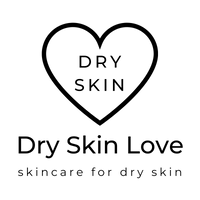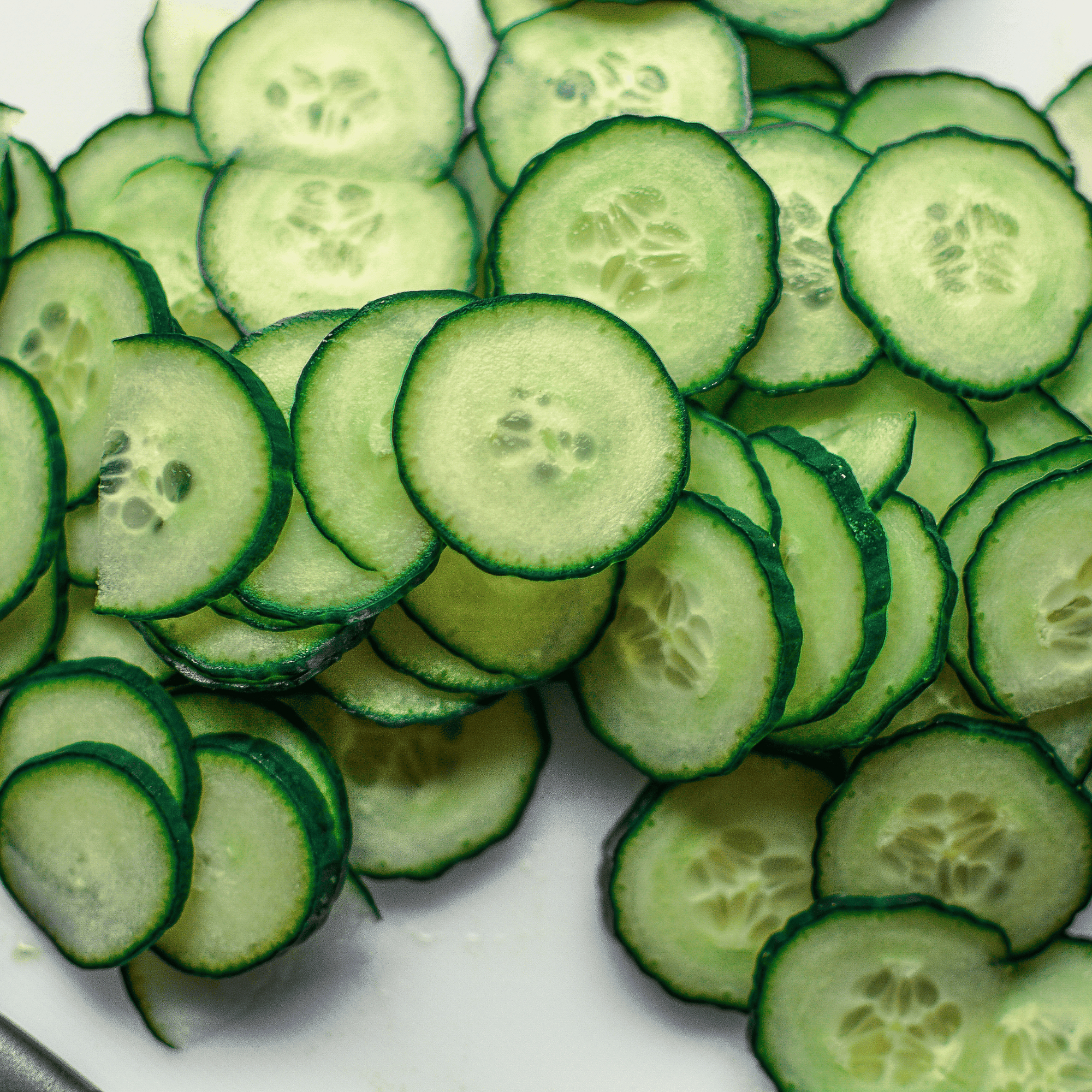Cucumber seed oil is a natural oil extracted from the seeds of cucumbers.
Cucumber seed oil is rich in nutrients, including essential fatty acids, phytosterols, squalene and vitamins.
Cucumber seed oil is known for its benefits in skincare and cosmetics due to its essential nutrients, lightweight texture and delightful aroma!
- What is cucumber seed oil?
- How is cucumber seed oil made?
- What does cucumber seed oil smell like?
- What color is cucumber seed oil?
- What does cucumber seed oil feel like?
- What is composition of cucumber seed oil?
- Summary
- References

What is cucumber seed oil?
INCI: Cucumis sativus (Cucumber) seed oil
Extraction Method: cold pressed
Appearance: clear to light yellow
Texture: lightweight, easily absorbed into skin
Aroma: light, fresh, cucumber-like aroma
Cucumber seed oil is a natural oil derived from the seeds of the cucumber.
Cucumber seed oil is cold-pressed from seeds that would otherwise go to waste and is considered a ‘zero waste’ seed oil.
Fruit and vegetable seeds are a major by-products of the food industry, and creating new uses for them by converting them to value-added products helps to prevent their disposal as waste, and promotes sustainable production.
Cucumber seed oil is rich in essential nutrients, including essential fatty acids, vitamin E and antioxidants.
Cucumber seed oil has many benefits for your skin.

How is cucumber seed oil made?
Cucumber seed oil is typically made through a process called cold pressing.
This method involves extracting the oil from the seeds without using heat or chemicals, which helps preserve the oil's nutritional and antioxidant properties.
Here’s a step-by-step outline of how cucumber seed oil is produced:
1. Seed Collection and Cleaning: Cucumber seeds are collected from the cucumbers and thoroughly cleaned to remove any pulp, dirt, or debris.
2. Drying: The cleaned seeds are then dried to reduce their moisture content. This is important to prevent mold growth and ensure efficient oil extraction.
3. Cold Pressing: The dried seeds are placed in a cold press machine. This machine applies mechanical pressure to the seeds without generating heat, which helps preserve the oil’s nutrients and delicate compounds. The pressing process extracts the oil from the seeds.
4. Filtration: The extracted oil is then filtered to remove any solid particles or impurities, resulting in a clear and pure oil.
The quality of the cucumber seed oil can vary depending on factors such as the quality of the seeds, the extraction method, and the storage conditions.

What does cucumber seed oil smell like?
Cucumber seed oil has a fresh, pleasant aroma that is reminiscent of fresh cucumber.
The intensity and specific scent of cucumber seed oil may vary depending on the quality of the seeds, the extraction process, and any additional processing or refining steps involved in the production of the oil.
Cold-pressed, unrefined cucumber seed oil has the strongest aroma, whereas processed oil has a faint aroma.

What color is cucumber seed oil?
The color of cucumber seed oil depends on how the seeds are processed and how the finished oil is refined.
Typically, cucumber seed oil is colorless to pale yellow colored liquid.

What does cucumber seed oil feel like?
Cucumber seed oil has a light, non-greasy texture.
It is easily absorbed by the skin, making it an ideal ingredient for skincare products.
This light texture allows it to provide effective hydration without leaving a heavy or oily residue, making it suitable for all skin types, including oily and acne-prone skin. Its quick absorption and smooth application make it popular for use in facial serums, moisturizers, and other cosmetic formulations.

What is composition of cucumber seed oil?
Cucumber seed oil is rich in nutrients, including essential fatty acids, phytosterols, squalene and vitamins.
Fatty acids
The fatty acid composition of cucumber seed oil is:
- 60 - 68% linoleic acid
- 14 - 20% oleic acid
- 9 - 13% palmitic acid
- 6 - 9% stearic acid
- 1% palmitoleic acid
- 1% alpha-linolenic acid
Cucumber seed oil contains ~68% linoleic acid, the major essential n-6 fatty acid found naturally in our skin. Linoleic acid is a precursor for ceramides, which are bioactive lipids that play a role in keeping our skin barrier firm, smooth and healthy.
Learn more: What is Linoleic Acid? Omega 6 Essential Fatty Acid for Dry Skin
Cucumber seed oil also contains 20% oleic acid and 13% palmitic acid, fatty acids which are found naturally in the protective outer layer of the skin, and help the skin retain moisture.
Phytosterols
Cucumber seed oil has been shown to contain high amounts of phytosterols with 9.814 mg/g total phytosterols (Yuenyong et al, 2021).
Phytosterols are plant-derived sterols that have a similar structure and functions as cholesterol.
The main phytosterols in plant oils are beta-sitosterol, campesterol, stigmasterol, brassicasterol, and delta5-avenasterol (Verleyen et al, 2002).
Cucumber seed oil contains 9.334 mg/g beta-sitosterol, and 0.480 mg/g stigmasterol and campesterol (combined) (Yuenyong et al, 2021).
The total phytosterol contents of plant oils has been shown to range between 1.42 and 18.91 mg/g (Yang et al, 2019).
Phytosterols such as stigmasterol are potent antioxidants and anti-inflammatory compounds (Bakrim et al, 2022).
Squalene
Cucumber seed oil contains squalene (Mahesh et al, 2017; Yuenyong et al, 2021; Soetjipto et al, 2023).
In a recent study, cucumber seed oil was shown to contain ~0.891 mg/g squalene (Yuenyong et al, 2021).
Squalene is an oily liquid hydrocarbon. Squalane is its hydrogenated form.
Squalene is naturally found in shark liver oil, human sebum and certain plant oils, including olive oil, palm oil, wheat-germ oil, amaranth oil, and rice bran oil (Huang et al, 2009).
Shark liver (Squalus) is the highest natural source of squalene and the name "squalene" originates from "Squalus" species of shark.
Human sebum naturally contains 13% squalene as one of its major constituents (Kim et al, 2012).
Squalene is a strong antioxidant and is also an emollient and can help the skin maintain hydration.
Squalene is non-greasy and quickly absorbed by the skin.
Vitamin E
Cucumber seed oil contains vitamin E.
Vitamin E is an essential nutrient and it has benefits for your skin.
When applied topically, vitamin E is a skin conditioning agent, a powerful antioxidant and it can protect your skin against photodamage from the sun.
There are 8 types of natural vitamin E. There are four tocopherols (alpha, beta, gamma and delta) and four tocotrienols (alpha, beta, gamma and delta).
Cucumber seed extract has been shown to contain gamma-tocopherol (Doshi et al, 2017).
Learn more: Vitamin E for Skin
Vitamin D3
Surprisingly, cucumber seed oil has been shown to contain 0.186 mg/g vitamin D3 (cholecalciferol) (Yuenyong et al, 2021).
Vitamin D3 is typically found in food products of animal origin, such as fatty fish, including salmon and sardines.
In a clinical trial, topical supplementation with a moisturizer containing 0.01 mg/g vitamin D3 significantly increased skin moisturization and improved dry skin, including the appearance of flakiness (Russell, 2012).

Summary
Cucumber seed oil is made by crushing cucumber seeds and collecting the oil.
Cucumber seed oil is cold-pressed from seeds that would otherwise go to waste and is considered a ‘zero waste’ seed oil.
Cucumber seed oil has a delightful aroma! Its is fresh and vibrant - similar to fresh cucumbers.
Cucumber seed oil has a light silky texture and is easily absorbed, leaving a non-greasy finish.
Cucumber seed oil is rich in nutrients, including essential fatty acids, phytosterols, squalene and vitamins, which have powerful antioxidant activity.

References
Bakrim S, Benkhaira N, Bourais I, Benali T, Lee LH, El Omari N, Sheikh RA, Goh KW, Ming LC, Bouyahya A. Health Benefits and Pharmacological Properties of Stigmasterol. Antioxidants (Basel). 2022 Sep 27;11(10):1912.
Doshi GM, Kanade PP. Identification and quantification of γ-tocopherol in Cucurbita pepo, Cucumis melo and Cucumis sativus seeds extracts by high performance liquid chromatography. Journal of Pharmacognosy and Phytochemistry. 2017;6(2):192-6.
Huang ZR, Lin YK, Fang JY. Biological and pharmacological activities of squalene and related compounds: potential uses in cosmetic dermatology. Molecules. 2009 Jan 23;14(1):540-54.
Kim SK, Karadeniz F. Biological importance and applications of squalene and squalane. Adv Food Nutr Res. 2012;65:223-33.
Li Y, Yuan F, Wu Y, Zhang Y, Gao B, Yu L. Triacylglycerols and Fatty Acid Compositions of Cucumber, Tomato, Pumpkin, and Carrot Seed Oils by Ultra-Performance Convergence Chromatography Combined with Quadrupole Time-of-Flight Mass Spectrometry. Foods. 2020 Jul 22;9(8):970.
Mahesh Doshi G, P Kanade P, Vilasrao Nalawade V, Kashinath Chaskar P. Chemical Characterization of Phytochemicals of Cucurbitaceae Family by Gas Chromatography–Mass Spectroscopy. Current Traditional Medicine. 2017 Aug 1;3(2):100-22.
Mariod AA, Ahmed YM, Matthäus B, Khaleel G, Siddig A, Gabra AM, Abdelwahab SI. A comparative study of the properties of six Sudanese cucurbit seeds and seed oils. Journal of the American Oil Chemists' Society. 2009 Dec;86(12):1181.
Murthy HN, Dewir YH, Dalawai D, Al-Suhaibani N. Comparative physicochemical analysis of seed oils of wild cucumber (Cucumis sativus var. hardwickii (Royle) Alef.), cucumber (Cucumis sativus L. var. sativus), and gherkin (Cucumis anguria L.). South African Journal of Botany. 2022 Mar 1;145:186-91.
Ngure JW, Cheng C, Yang S, Lou Q, Li J, Qian C, Chen J, Chen J. Cultivar and seasonal effects on seed oil content and fatty acid composition of cucumber as a potential industrial crop. Journal of the American Society for Horticultural Science. 2015 Jul 1;140(4):362-72.
Oragwu Ifeoma P, Okolo Azubike J, Emmanuel Ifeanyi V, Okoli Precious O, Osuagwu CC, Onyia OE, Usiakpebru AA, Okechukwu James O. Phytochemical and Proximate Composition of Cucumber (Cucumis Sativus) Seed Oil. International Journal of Research and Scientific Innovation (IJRSI) | Volume VIII, Issue II, February 2021.
Russell M. Assessing the relationship between vitamin D3 and stratum corneum hydration for the treatment of xerotic skin. Nutrients. 2012 Sep;4(9):1213-8.
Siaka Sorho, Soro Yaya, Adima Amissa Augustin and Lemee Laurent, 2006. Fatty Acids and Unsaponifiable Composition of Cucumis amaris Seeds Oil. Journal of Applied Sciences, 6: 3167-3169.
Soetjipto H, Febriyanti T, Kristijanto AI. Fatty Acid Profile and Squalene Content in Cucumber Seed Oil (Cucumis sativus). Molekul. 2023 Jul 10;18(2):300-6.
Wu XY, Chao ZM, Wang C, Tan ZG, Sun W. [Chemical constituents contained in fatty oil from seeds of Cucumis sativus]. Zhongguo Zhong Yao Za Zhi. 2012 Nov;37(21):3252-5. Article in Chinese.
Yang R, Xue L, Zhang L, Wang X, Qi X, Jiang J, Yu L, Wang X, Zhang W, Zhang Q, Li P. Phytosterol Contents of Edible Oils and Their Contributions to Estimated Phytosterol Intake in the Chinese Diet. Foods. 2019 Aug 9;8(8):334.
Yuenyong J, Pokkanta P, Phuangsaijai N, Kittiwachana S, Mahatheeranont S, Sookwong P. GC-MS and HPLC-DAD analysis of fatty acid profile and functional phytochemicals in fifty cold-pressed plant oils in Thailand. Heliyon. 2021 Feb 20;7(2):e06304.
Author Information

Dr. Natasha Ryz is a scientist, skin care expert and an entrepreneur. She is the founder of Dry Skin Love Skincare, and she creates skincare products for beauty, dry skin and pain relief.
Dr. Ryz has a PhD in Experimental Medicine from the University of British Columbia in Vancouver, and she is a Vanier scholar. She also holds a Master of Science degree and a Bachelor of Science degree from the University of Manitoba in Winnipeg.
Natasha is the former Chief Science Officer of Zenabis Global, and she oversaw extraction, analytics, and product development. Her team brought 20 products to market including oils, sprays, vapes and softgels.
Why I Started A Skincare Company

